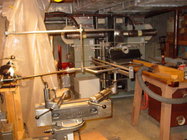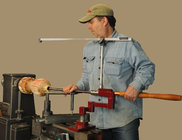I've noticed two types of hollowing systems. One is the articulating elbow (Trent Bosch, Elbow, Simple Hollowing, etc.). Another is the rectangle captured near the tailstock with a horizontal slot to react the torsion (Oneway, Jamieson).
Has anyone used both designs? Could you describe the advantages/disadvantages of each? Thanks for the insight!
I’ve used the Jamison since 2000. Made a plywood back rest. lyle wasn’t making back rests then.
added a laser then used boat rail fitting to Mount the laser with pipes. Replaced it with a Bosch vizualizer ( video).
hollowforms are my mainstay and I been invited to do demos lots of places. Taught a half dozen hollowing classes using the Jamison.
in 2016 I bought a Simon Hope articulated system. I’ve mostly used the Hope because It sets up for a different height lathe in about 30 seconds. So when I do a florida demo it’s a ready go when I need it I just have to slide a collar up and lock it with a level on the hollowing bar. Too heavy to fly with. the jaimison I have several traveling wooden backrests. I screw them to the base to adjust the height. Takes 5-10 minutes clamping and testing height, fine tuning height clamping, running in the screws. Lyle Has loaned me back rests quite a few times for demos.
5” H x 14” W forms are easier with the Hope. With the Jamieson I have to swing the backrest out and back to reach some spots.
note these wide forms can’t be hollowed with all the articulated systems.
10”H x 5D forms are easier with the. jaimison
But there is little difference in performance between the Jamison and the Hope. They are both great as are others.
I think my video set up is more compatible with the Hope.
I like the hope. But considering price. I‘d recommend the Jamison handle, bosch hollowing bars, make a backrest from plywood.
you can hollow anything safely, with good posture, add a video system or laser. the cutters and scrapers for the bosch tools are great too.


